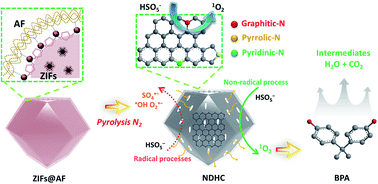Confined pyrolysis of metal–organic frameworks to N-doped hierarchical carbon for non-radical dominated advanced oxidation processes†
Abstract
Development of metal–organic framework (MOF) derived carbon materials toward advanced oxidation processes (AOPs) is essential for environment-friendly catalysts. In this work, a confined pyrolysis strategy to prepare N-doped hierarchical carbon (NDHC) catalysts for non-radical advanced oxidation processes is proposed. After simply pyrolyzing phenolic resin (PR) coated zeolite imidazole framework (ZIF) particles, NDHC with favorable structural and compositional properties is obtained. To present the catalytic performance of resultant NDHC, bisphenol A (BPA) is selected as the target contaminant. The results show that 98% of BPA (20 ppm) was removed by NDHC in 5 min, which is superior to many other peroxymonosulfate (PMS) catalysts. Based on electron paramagnetic resonance (EPR) analysis and scavenger experiments, a singlet oxygen-dominated non-radical mechanism is confirmed in the degradation process. In addition, the influencing factors including solution pH, catalyst/PMS dosage, BPA concentration, reaction temperature, and anion/organic matter are also investigated. This confined pyrolysis strategy endows MOF derived carbon materials wide application prospects in environmental remediation.



 Please wait while we load your content...
Please wait while we load your content...